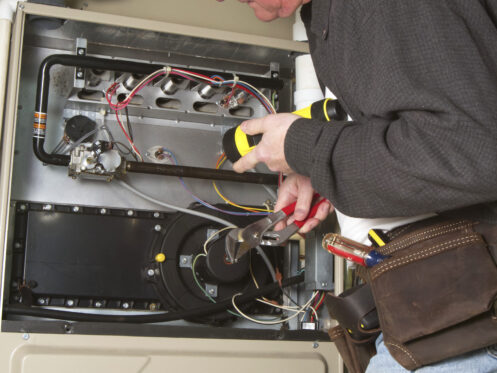Furnace filters should be inspected monthly and changed at least every one to three months to keep your indoor air clean and protect your heating system. You can check your filter by removing it from the furnace and holding it up to an overhead light. If light can pass through the filter, so can air. Over time, filters will collect lint-like debris that requires your furnace to work harder to push air through, so if you cannot see through your filters, it’s time to replace them.
Dark soot-like buildup and a more frequent need for filter changes can indicate potentially serious issues. If your filter is still relatively new and is covered by black sooty deposits, you may need to contact a professional. Read on to find out how to protect your Wheat Ridge, CO home when suspicious buildup forms on your furnace filter.
How Fast Is Too Fast for an HVAC Air Filter to Get Dirty?
For most households, changing air filters every one to three months is sufficient. However, you might need to swap your furnace filter out more often if:
- One or more residents have a chronic respiratory ailment
- You have multiple indoor pets
- Your lot hasn’t been landscaped
- There’s active construction nearby
- You live near a freeway, airport, or busy street
If none of these factors apply, changing your filter every two to three weeks is excessive. More importantly, it could mean that your HVAC system is malfunctioning. This is even more true if your dirty filters are black and sooty, which can indicate serious health and safety hazards.
Carbon Monoxide Leaks and Black Furnace Filters
If you have a fuel-burning furnace in your home, your first concern is ruling out carbon monoxide leaks. Carbon monoxide (CO) is an odorless, colorless gas that fuel-combustion appliances produce when burning heating oil, natural gas, or any other fuel incompletely. All fuel-combustion furnaces produce CO given that no gas-fired or oil-fired furnace is 100% efficient.
When fuel-fired heating systems are working as they should, CO and other emissions are routed out of buildings via their attached venting systems. Your furnace exhaust pipe may have collapsed, or the outdoor vent could be blocked by a nest, general yard debris, or frozen precipitation.
Keep in mind that if you have a fuel-combustion furnace, you may have a fuel-combustion water heater too. Thus, when CO problems are suspected, having both units inspected and repaired or maintained is critical to your safety.
Overly Tight Home Envelopes and the Potential for Back-Drafting
To reduce energy waste, homeowners throughout the nation are being encouraged to create increasingly airtight homes. Unfortunately, these recommendations often overlook the need for adequate ventilation. With weatherstripping, added insulation, and caulk or other materials for sealing up air leaks, you can both save energy and create the risk of developing negative air pressure.
With your furnace drawing air from the interior of the building and releasing exhaust outdoors, even something as simple as turning your bathroom exhaust fan on or using your range hood vent could cause a dangerous back-draft. With back-drafting, combustion gasses from fuel-burning appliances are pulled back into living areas until negative air pressure is corrected.
Airflow Obstructions and Dirty Furnace Filters
If you haven’t had your furnace professionally maintained in a while, there’s a good chance that a buildup of dirt and debris in other areas is affecting the combustion process. For instance, you might have a blocked intake valve that’s inhibiting the flow of air at your furnace’s pilot light or burners. Without sufficient oxygen, furnaces cannot burn fuel efficiently and release higher-than-normal amounts of carbon monoxide.
Why Aren’t My Carbon Monoxide Alarms Going Off?
To protect homeowners from the odorless, colorless threat of CO exposure, carbon monoxide alarms are installed in all buildings that have fuel-combustion appliances. Although furnace venting systems are effective for routing most emissions out of the building, many furnaces have small amounts of CO and other exhaust gasses around their perimeters. To avoid triggering false alarms, HVAC technicians and other professionals install CO devices at least nine feet away from heating equipment.
If you have small amounts of CO gas back-drafting into the building or being blocked by a vent obstruction, there may be enough exhaust to dirty your HVAC air filter, but not enough to trigger an alarm. However, another possibility is that your CO alarms have reached the ends of their lifespans, need new batteries, or aren’t working as they should. Most CO alarms last seven to 10 years, and they require replacement batteries every six months. Even if your CO alarms are hardwired into your home’s electrical system, you should replace their backup batteries at least once annually.
Dark Build-ups of Soot on Your HVAC Air Filter
Carbon monoxide leaks are one cause of black, sooty air filters. However, if you have a fireplace in your home or regularly burn scented candles, these things can also create excess amounts of soot. Not only do scented candles and poorly maintained fireplaces decrease the service lives of HVAC air filters, but they can also leave greasy buildup on your walls, lower your indoor air quality (IAQ), and trigger or exacerbate common respiratory conditions like asthma and allergies.
How to Solve the Problem
Have your fireplace flue cleaned annually. Doing so will decrease your risk of chimney fires and improve your indoor air quality (IAQ). It will also make your furnace filters last a bit longer.
If using your fireplace is causing your furnace filter to turn black fast, stop using this feature right away until it’s been properly maintained. It’s also important to note that using your fireplace and your furnace together is hardly efficient. Keeping your flue open while your heater is on allows heated air to escape the building.
Finally, consider swapping your scented candles out for natural options. Candles that are made from soy or beeswax and perfumed with essential oils release a lot less soot. For optimum IAQ benefits, use battery-powered candles for ambiance instead.
Black Speckles of Mold
Not all black-colored filters are covered in a uniform layer of thick, greasy soot. You might pull your filter and find countless tiny, black or dark-brown dots. These are an indication of mold. Fortunately, in many cases, moldy filters are the result of fixable HVAC problems. The key to keeping them contained and eliminating them swiftly is to respond fast. Rather than simply swapping moldy filters out, you should always schedule HVAC service to find out why this problem is happening.
Dirty Condensate Drains and Mold Problems
Among the most common causes of moldy filters are blocked condensate drains. HVAC systems don’t just heat and cool homes. They also extract excess humidity. This humidity leaves the building as condensation via the condensate drain line.
When heaters and air conditioners don’t get the annual maintenance they need, their lines can get clogged by fast-growing bacteria or algal blooms. When they do, building interiors will feel muggy, clammy, or oppressive, heaters and air conditioners will work harder, and patches of mold and mildew will appear.
Schedule Annual Furnace Maintenance to Maintain a Healthy IAQ
The best way to protect your indoor air quality is by scheduling annual furnace maintenance. Giving your air conditioner the same level of care will help too. During these visits, we clear out airflow obstructions that negatively affect HVAC performance and humidity regulation. We inspect and repair furnace venting systems and assess the risk of back-drafting. We also check and test CO alarms and change their batteries as needed.
As a small, family-owned business, we’re proud to serve Wheat Ridge, CO and the surrounding communities. We offer exceptional furnace and air conditioner maintenance, installation, and repairs. We also provide cutting-edge indoor air quality improvements, water heaters, and electrical services. Contact Mighty Pine Heating & Air today to schedule an appointment.



